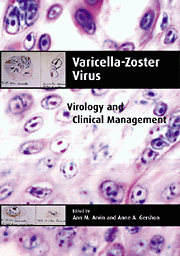1 - Historical perspective
from Part I - History
Published online by Cambridge University Press: 02 March 2010
Summary
Introduction
The development of our knowledge of the ubiquitous varicella-zoster virus has been fascinating, illustrating as it does the interplay of different scientific disciplines and the changing nature of the human host. Initially, clinicians differentiated varicella from variola. Then, epidemiologists provided evidence in support of the view that chickenpox and shingles had a common etiology, a thesis supported by pathologists who studied the lesions. Additional evidence of co-identity was provided on cultivation of the viruses in the laboratory. Yet proof of this fact a waited the application of molecular biological techniques.
Concurrently, and paradoxically in large part due to the advances of curative medicine, varicella lost its benign label as an ever-increasing number of high risk subjects in whom varicella might be lethal was recognized. Also concurrently in the developed countries the prevalence of zoster increased in parallel with the increasing longevity of the human population. As varicella emerged as a lethal disease, the need for therapeutic drugs and vaccines became obvious and the efforts of pharmacologists and immunologists yielded effective antiviral drugs and vaccines.
The differentiation of varicella from variola
Whereas zoster was recognized and described in medieval times, varicella was considered to be a mild form of smallpox until 1767 when Heberden read a paper entitled “On the Chickenpox” before the College of Physicians in London (Heberden, 1768).
- Type
- Chapter
- Information
- Varicella-Zoster VirusVirology and Clinical Management, pp. 9 - 22Publisher: Cambridge University PressPrint publication year: 2000
- 2
- Cited by

